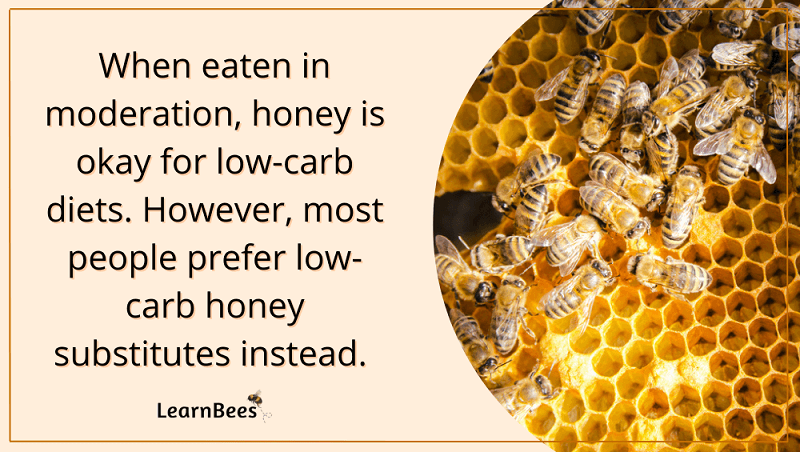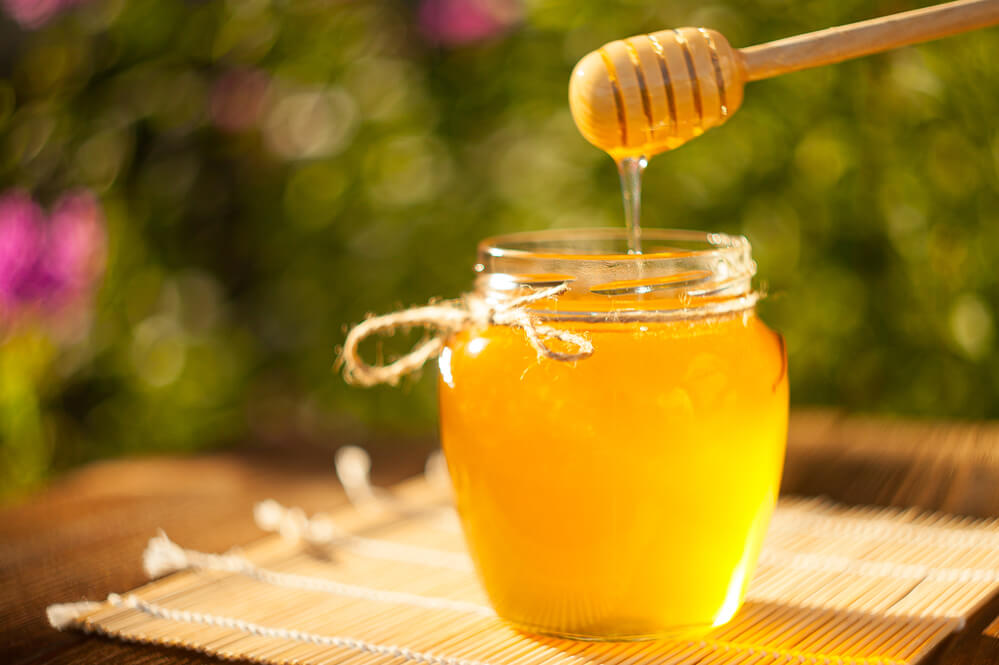Table of Contents:
How Many Carbs Are in Honey?

One tablespoon of honey contains 17.5 grams of total carbs and 64 calories.
A low-carb diet is generally considered anything under 130 grams of carbohydrates per day (or less than 26% of total calories).(1)
A very low-carb diet, such as keto, recommends eating less than 50 grams of carbohydrates per day (or less than 10% of total calories).(2)
Additional nutrition information for one tablespoon of honey (21 grams) is as follows:(3)
- Calories: 64
- Carbohydrates: 17.5g
- Fat: 0g
- Protein: 0.1g
- Sodium: 0mg
- Fiber: 0g
- Sugars: 17g
- Potassium: 10.9mg
- Iron: 0.1mg
- Calcium: 1.3mg
Is Honey OK on a Low-Carb Diet?

Honey is fine for low-carb diets if it’s eaten in moderation.
With that in mind, many people don’t want to waste 17.5 grams of carbs on a single tablespoon of honey. In that case, we recommend a low-carb honey substitute instead.
Remember:
Many people on low-carb or keto diets only count “net carbs.”
Net carbs are total carbs minus fiber. Fiber gets subtracted from total carbs because it isn’t digestible and doesn’t cause an insulin response.
So here’s how that works for this low-carb honey substitute:
Total Carbs (19g) – Fiber (18g) = 1 net carb
As such, one net carb is considered a low-carb food.
At the end of the day?
The answer to “Can I eat XYZ?” is always “Yes, if it fits your macros.” This means if you’re on a low-carb diet, then you should stay within your carb and calorie limits.
But one of the biggest questions we get asked is:
Will a little honey kick me out of ketosis?
Usually, to be knocked out of ketosis, you need around 50 grams of carbs daily or more. So you won’t be kicked out of ketosis if you stay within that limit. You could sweeten your coffee with a tablespoon of honey if you wanted.
Or, you could minimize your carb intake by choosing a keto honey substitute instead.
Is Honey Better Than Sugar for Carbs?

Honey is not better than sugar for carbs. Honey contains 17.5 grams of total carbs and 64 calories per tablespoon. Sugar has 13 grams of total carbs and 49 calories per tablespoon.
Then why do people choose honey over sugar?
Because raw honey contains health benefits that sugar doesn’t have.
For example, honey is antibacterial and anti-inflammatory, so it’s been shown to ease coughing and sore throats associated with upper respiratory infections. In addition, honey has been successfully used in clinical settings to prevent infections in skin wounds.
Here are a few ways honey is better than sugar:
Benefit 1: Raw Honey Can Boost Heart Health

A recent study found that eating honey in moderation can reduce inflammation and decrease your cardiometabolic risk—factors that increase your likelihood of developing heart disease.(4)
Researchers discovered that adding honey to a healthy diet reduced several cardiometabolic risk (CMR) factors, including:
- Total and LDL cholesterol
- Fasting blood glucose (sugar)
- Triglycerides (fats)
What’s more, honey was shown to increase HDL (“good”) cholesterol. The most benefits were from raw honey from a single floral source.
For example, buckwheat honey is considered a “monofloral” honey because it comes from buckwheat plants. In contrast, wildflower honey is considered a “polyfloral” honey because it comes from various plants.
In addition, raw honey has shown benefits of lowering blood pressure, improving blood fat levels, stopping healthy cells from dying, and regulating heartbeats – all things that boost overall heart health.(5)
Benefit 2: Honey Can Help With Sore Throats and Coughs

For people with upper respiratory infections, coughing is a frustrating symptom that can make it difficult to sleep at night. Honey can help ease these symptoms.
Several studies have compared the effectiveness of honey and diphenhydramine (a cough medicine ingredient) for treating cough symptoms, with honey consistently outperforming the cough medicine ingredient.(6)
Not to mention, some popular cough medicines come with adverse reactions like blurred vision, breathing issues, and nausea.
Raw honey has none of these harmful side effects.
In addition, honey has been shown to improve sleep quality for children with coughs and their parents.(7)
A review of studies showed that honey could be a more effective treatment option for upper respiratory tract infections compared to other treatments.(8)
Another study found that honey can be effective in healing a sore throat. Honey has antibacterial and anti-inflammatory properties, which help with the healing process.(9)
Benefit 3: Honey Provides a Good Source of Antioxidants

Honey contains many antioxidants, which are responsible for many of its health benefits.
Antioxidants are helpful molecules that diminish the presence of dangerous free radicals in our system. Free radicals have been linked to several issues, such as aging, cancer, and diseases.
In a study with 25 participants, researchers had them add four tablespoons of buckwheat honey to their daily diets and took blood samples before and after the study. Subjects who ate the honey for 29 days had increased levels of polyphenols, which are antioxidants that fight diseases.(10, 11)
The more honey the individuals ate that was rich in polyphenols, their blood antioxidant levels were higher.
Studies have shown that the antioxidants in raw honey can help protect you from conditions caused by oxidative stress.(12)
Benefit 4: Honey Can Heal Wounds and Burns

Raw honey is an excellent skin treatment thanks to its antibacterial, antiviral, antifungal, and anti-inflammatory properties.
It can help treat minor acne blemishes to serious skin concerns, such as diabetes-related foot ulcers.
A review of studies found that honey can effectively heal partial-thickness burns and surgical wounds that become infected.
A separate study discovered that honey was 97% successful in treating diabetes-related foot ulcers. If left untreated, such foot ulcers can lead to amputation.
In addition, honey is beneficial in treating other skin problems, such as herpes, eczema, and psoriasis.
Honey may also be beneficial for treating:
- Skin rashes
- Cuts
- Scrapes
- Sunburns
- Inflammation
Benefit 5: Honey Can Aid in Better Digestion

Honey is sometimes used to treat digestive difficulties, such as diarrhea. Some researchers believe that honey may have healing properties for treating Helicobacter pylori bacteria, which is a common cause of stomach ulcers.
Not only is raw honey delicious, but it also contains prebiotics—substances that nurture the good bacteria in your intestines. This helps with both digestion and keeping you healthy overall.
However, honey should not be given to young children under one because it can contain spores of a bacterium that can cause infant botulism.
And although some research indicates the efficacy of honey on digestion, the research so far is limited.
FAQs On “How Many Carbs Are in Honey?”
- Is honey good on a low-carb diet?
- Can you have any honey on keto?
- Is natural honey high in carbs?
- How many net carbs are in a teaspoon of honey?
- Will a small amount of honey knock me out of ketosis?
- Is honey worse than sugar for carbs?
- How many carbs are in raw honey?
- Is there a low-carb honey substitute?
Is honey good on a low-carb diet?
Honey is okay on a low-carb diet as long as it’s eaten in moderation. However, many people choose not to eat honey because one tablespoon contains a large number of carbs. Using 17.5 grams of carbs in a single tablespoon doesn’t make sense for most.
If you decide to eat honey on a low-carb or keto diet, you must carefully monitor your other carbs, so you don’t exceed your daily limit.
In this case, a low-carb honey substitute may be a better option. These substitutes contain low net carbs and still taste sweet.
However, substitutes aren’t considered real honey, so they don’t have antioxidant benefits.
—> Go back to the FAQs on “How Many Carbs Are in Honey?”
More to Explore:
- Honey Pasteurization: Does it Ruin Raw Honey?
- Honey for Skin Benefits: Directions, Uses, & Risks
- 8 Scientific Benefits of Raw Honey
Can you have any honey on keto?
You can have honey in moderation on keto. That said, honey contains many carbohydrates, so a single tablespoon takes up a large portion of your carbohydrate intake.
If you decide to have some honey on a low-carb diet, then adjust your other food choices accordingly.
You can also use low-carb sweeteners, such as honey substitutes or monk fruit sweeteners. Monk fruit, for example, contains zero carbs and calories.
—> Go back to the FAQs on “How Many Carbs Are in Honey?”
More to Explore:
Is natural honey high in carbs?
Natural, raw honey is high in carbs because it contains 17.5 grams of carbs per tablespoon.
But it’s important to mention:
The term “natural” honey is a general term that doesn’t mean what you might think. If you’re looking for honey unaltered from the hive, then you’re looking for “raw” honey.
Raw honey hasn’t been pasteurized, heated, or diluted with artificial sweeteners. The label should say “raw honey” on it. Don’t rely on buzzwords such as “organic,” “natural,” “pure,” and “real.” These words don’t always mean that the honey is raw and unaltered.
—> Go back to the FAQs on “How Many Carbs Are in Honey?”
More to Explore:
- The Top 3 Best Manuka Honey Brands
- Orange Blossom Honey: Uses, Benefits, & Risks
- Sourwood Honey: Uses, Benefits, & Risks
How many net carbs are in a teaspoon of honey?
One teaspoon of honey contains about six net carbs.
Net carbs are essentially the carbohydrates in food that your body can break down and use for energy. To figure out net carbs, subtract a food’s fiber from its total carbohydrates.
Our body cannot break down fiber, so it goes through our digestive system unchanged. Fiber also doesn’t cause an insulin response.
—> Go back to the FAQs on “How Many Carbs Are in Honey?”
More to Explore:
Will a small amount of honey knock me out of ketosis?
A little honey shouldn’t kick you out of ketosis as long as you stay under 50 grams of carbs daily. However, most people on low-carb diets choose not to eat honey because one tablespoon contains a high number of carbs.
You can eat honey in moderation on a low-carb diet as long as you’re strict with the number of other carbs you eat.
—> Go back to the FAQs on “How Many Carbs Are in Honey?”
More to Explore:
Is honey worse than sugar for carbs?
Honey is “worse” than sugar for carbs because it contains 17.5 grams of carbs compared to the 13 grams that sugar contains.
The main benefit of raw honey is that it contains antioxidants that are beneficial to your body. It’s also antimicrobial and anti-inflammatory, so it’s good for the skin.
If you’re looking for a low-carb sweetener, honey substitutes or monk fruit sweeteners may be a better option.
—> Go back to the FAQs on “How Many Carbs Are in Honey?”
More to Explore:
How many carbs are in raw honey?
Raw honey contains 17.5 grams of carbs per tablespoon.
To ensure you’re getting real, raw honey, look for labels that say “raw.” Don’t depend on buzzwords such as “pure,” “real,” or “natural” because they don’t necessarily mean the honey is raw.
—> Go back to the FAQs on “How Many Carbs Are in Honey?”
More to Explore:
- How to Make Beeswax Lip Balm
- Beeswax vs. Soy Wax: Which is Better for Candle Making?
- What Is Black Honey?
Is there a low-carb honey substitute?
There are several low-carb honey substitutes on the market. These honey substitutes are often called “keto honey” because they have a low number of net carbs. In addition, some people use low-calorie sweeteners such as monk fruit as a sweet substitute for honey.
But keep in mind:
Honey substitutes aren’t real honey, so they don’t include antimicrobial and antioxidant benefits.





